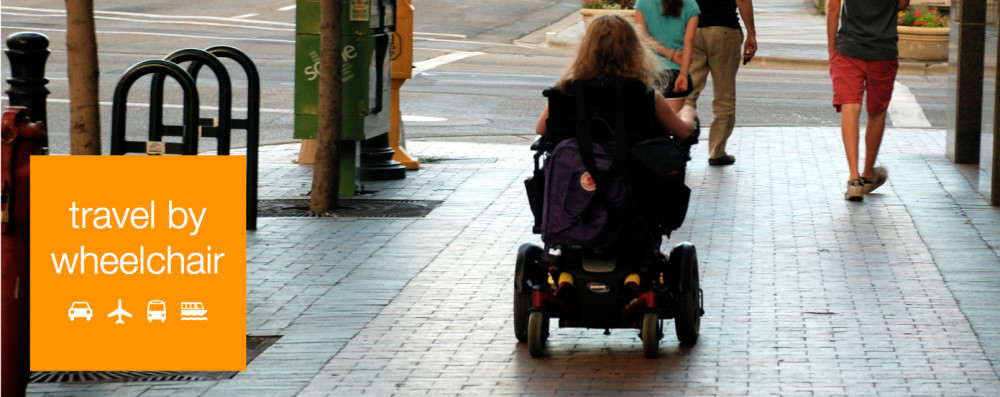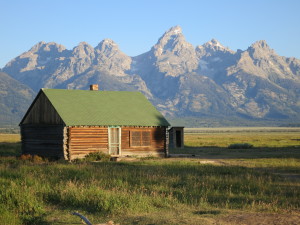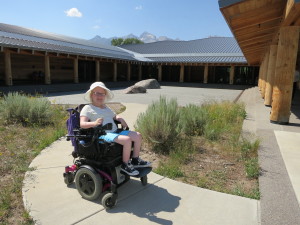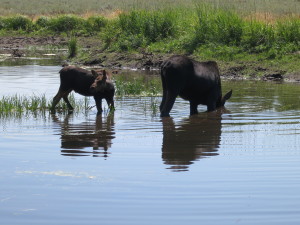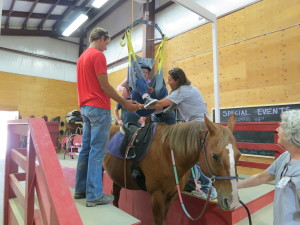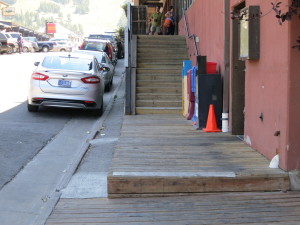Years of parenting have taught me that my kids will tolerate a short stint in a museum if they are promised: a) candy b) ice cream or c) decaf coffee (if the kid in question is Marianne).
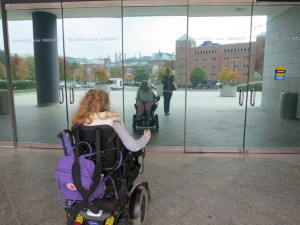
The Museum of Fine Arts, Boston
Recently, Marianne and I checked out two Boston museums, the Museum of Fine Arts (MFA) and the Institute of Contemporary Art (ICA). The MFA is wondrously, marvellously accessible. I could spend all day there (Marianne, not so much, and promises of decaf coffee only go so far).
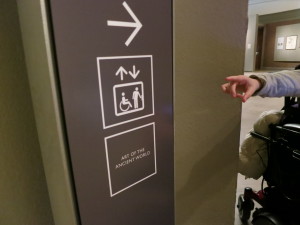
MFA, Boston
Many of the interior doors are outfitted with accessible door openers, as are the exterior doors. There is plenty of clear signage to direct you. Docents are everywhere, and in our experience, they are extremely helpful; one even took a picture for me of the two of us! Bathrooms and water fountains are on every floor, with excellent wheelchair access. There is an accessible Green Line T stop across the street, and there is decent parking in an outside lot (two caveats: it is expensive at $10, and that is with the membership discount, and there seem to be only about five ADA parking spaces). There are multiple venues to have a bite to eat, ranging from the expensive restaurant Bravo on Floor 2 to the serve-yourself cafeteria on the lower level. There is also a glorified coffee shop on the first floor (Taste cafe) and a more upscale cafe (The New American Cafe) near the Chihuly glass in the museum’s indoor courtyard. We had a terrible but inexpensive latte at Taste; I think I’d schedule a little more time and budget for The New American Cafe next time around.
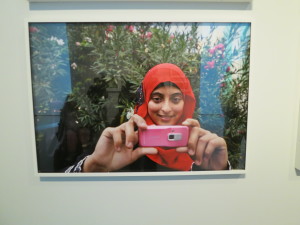
Photograph from “She Who Tells A Story” at the MFA, Boston
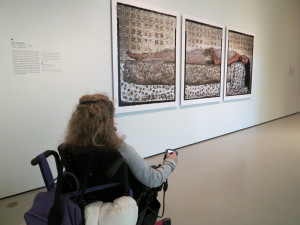
“She Who Tells A Story” exhibit at the MFA
If John Singer Sargent is your cup of tea, there is an exhibit running at the MFA until January 24, 2014. Marianne and I skipped it in favor of “She Who Tells A Story: Women Photographers from Iran and the Arab World.” The title describes it, but you really have to see it for yourself (showing through January 12, 2014). I can’t recommend this exhibit enough; it’s thought-provoking, mesmerizing, disturbing, and more. (Note: there is a curator talk on Thursday, December 19th from 6:30 to 7:30 pm in Remis Auditorium; tickets on sale as of November 21st)
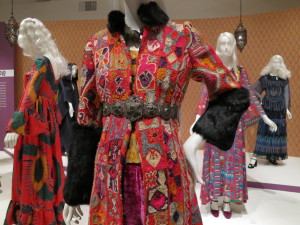
Hippie Chic exhibit at MFA, Boston
We also visited the Hippie Chic exhibit (all clothes from the 70’s) and Think Pink (small exhibit that explores the significance of the color pink throughout history). Interesting, but I’d skip these two exhibits next time and spend all my time with the photographers in “She Who Tells A Story.”
I used to be able to get guest passes for the MFA at our local library; if that doesn’t work, single admission is $25 (7-17 are free after 3 pm on weekdays and on weekends). I bought a membership at the supporter level for $75 which gives me and my children (17 and under) free admission for the year, plus a discount on parking and at the gift shop. That’s two more visits, kids!
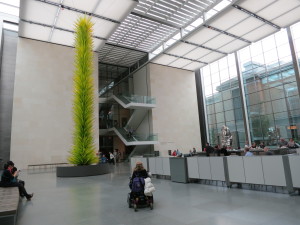
Chihuly sculpture and The New American Cafe space at the MFA, Boston
In my experience, weekends are crazy busy at the MFA. If you can get there late afternoon, say an hour and a half before closing on a weekday, it’s quiet. Wednesday through Friday night they are open until 9:45 pm, which might also be a promising time to visit. And if you’re over 21, you can enjoy a glass of wine at either The New American Cafe or Taste, the coffee shop on Floor One that doubles as a wine bar!
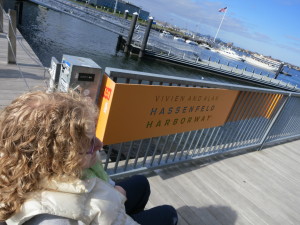
The Harborwalk, Boston, near the Institute for Contemporary Art
The Institute of Contemporary Art (ICA) has beautiful, industrial space and has the advantage of sitting on the Boston harbor, with the Harborwalk running alongside and beyond. The Harborwalk will remain a separate adventure – and blog post. Suffice it to say, for now, that there are almost 40 miles of pathway and many segments are ADA-compliant. Of course, the big question is: which sections aren’t?! I’ll let you know.
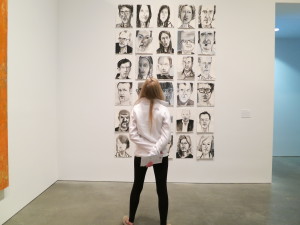
Amy Sillman’s exhibit, “one lump or two” at the ICA, Boston
Amy Sillman’s exhibit “one lump or two” is on exhibit now through January 5, 2014. I appreciate her use of color in the abstract pieces, but it’s the faces she creates that I love. That alone is worth the price of admission to me ($15 for an adult, kids 17 and under are free; Thursday nights all are free from 5 to 9 pm). The other space I appreciate at the ICA is the media lab, which looks out over the harbor as though through a camera viewfinder, and which has computer resources for researching contemporary art, artists or exhibits at the ICA. The top level is accessible, and has two accessible computers, but the other three or four levels in the lab are not. There is a kid-friendly (and teenager/wheelchair-friendly) art space on the first floor with ongoing projects for kids and teens.
The downside to the ICA: the only parking, really, is at a public lot that charges $15/day. The parking lot is in rough shape, and the wheelchair access through a gate doubles as a parking spot….so you have to hope that the car parked in the spot has left enough room not only for a thin person but also for a wheelchair or carriage. Seems wrong to put the spot there, somehow.
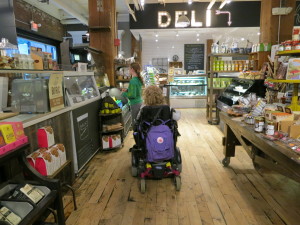
The Bee’s Knees Supply Company, Farnsworth Street, Boston
We walked and motored to the Bee’s Knees Supply Company for an early dinner. The Bee’s Knees has a little bit of everything: deli, sit-down cafe with great pizza and salad, wine story, charcuterie – in short, a gourmet grocery store, with in-store light dining. The real reason we braved the sidewalks (see photos – ARGHH!): the salted caramel ice cream. Oh joy! Oh rapture! We’d brave these sidewalks again for that ice cream. Our friend thought the pumpkin latte (seasonal, I am sure) was also de-lish.
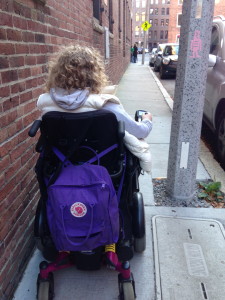
Teeny tiny sidewalk space near Sleeper Street, Boston
But don’t wheel there, as we did, from the ICA. Yikes. The whole area around the ICA is still very much a work-in-progress, and the sidewalks are in terrible shape with potholes and sporadic curb cuts. There are not enough crosswalks either. The side streets around Sleeper Street, where the Bee’s Knees Supply Company is, are even worse. The sidewalks are not always wide enough and there are holes galore. Go there for sure, but not on foot or wheelchair from the ICA!
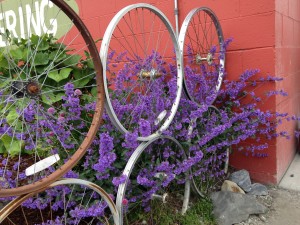 Alaska is the home of the grizzly bear, avid fisher-folk, cruise-ship mavens, hipsters and artists, and the highly-caffeinated. It is not, in general, an easy state for a wheelchair-user to navigate, but Anchorage stands out as an oasis. (In the summer, that is.)
Alaska is the home of the grizzly bear, avid fisher-folk, cruise-ship mavens, hipsters and artists, and the highly-caffeinated. It is not, in general, an easy state for a wheelchair-user to navigate, but Anchorage stands out as an oasis. (In the summer, that is.)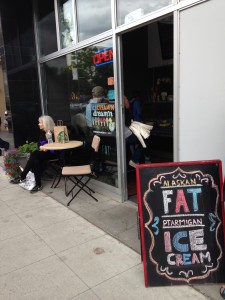
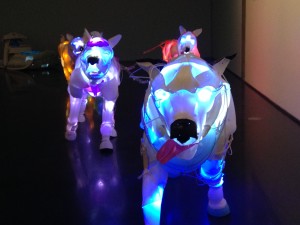
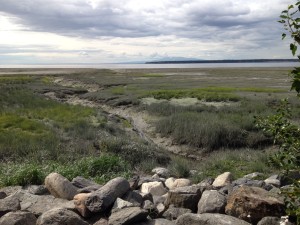
 Anchorage and its surrounds provide an adventurous day or two (maybe three) if you’re a slow walker or wheelchair-user. Those long daylight hours of summer give you even more time to get around, and the abundance of espresso shops can only help keep you motoring along.
Anchorage and its surrounds provide an adventurous day or two (maybe three) if you’re a slow walker or wheelchair-user. Those long daylight hours of summer give you even more time to get around, and the abundance of espresso shops can only help keep you motoring along.